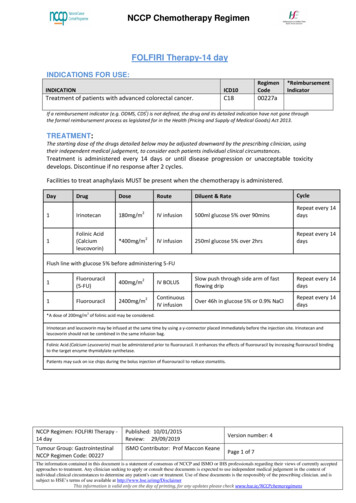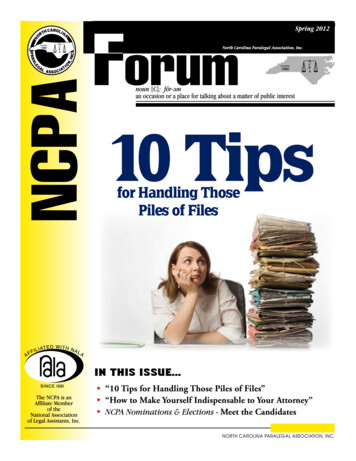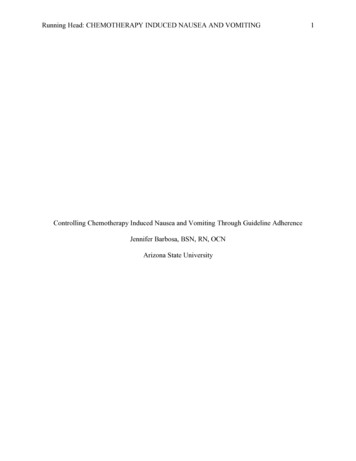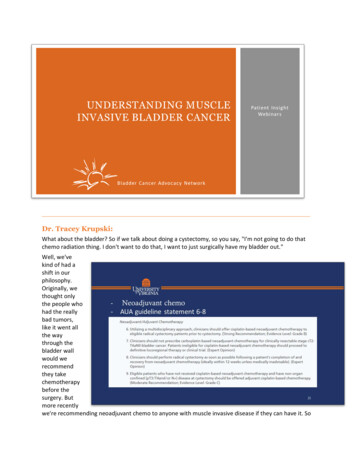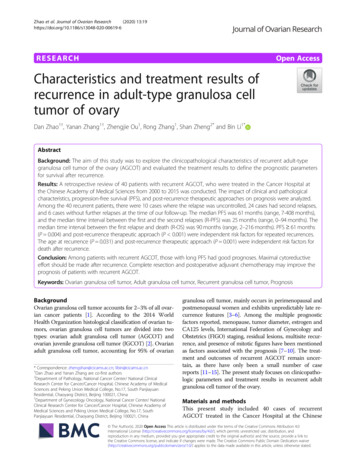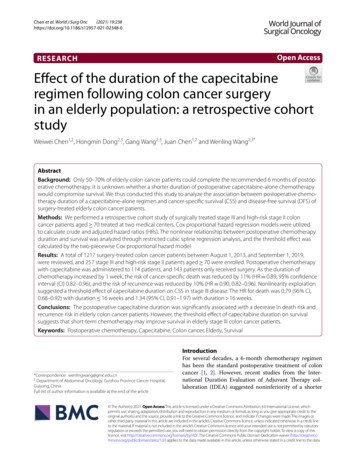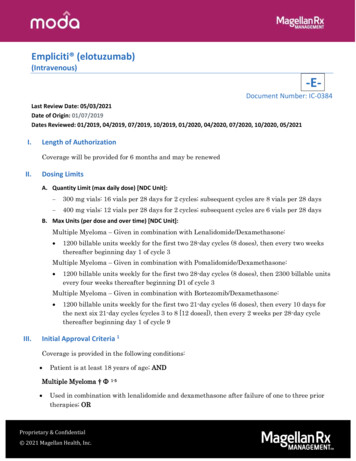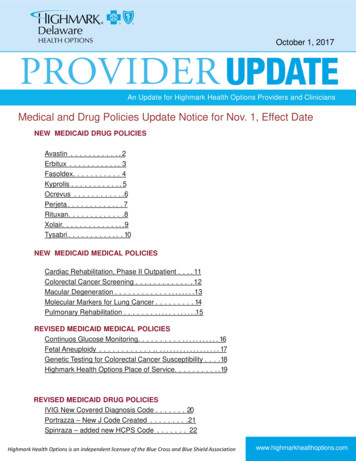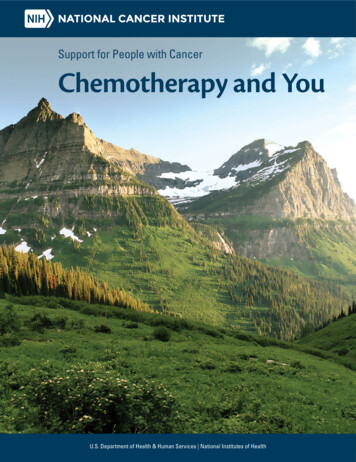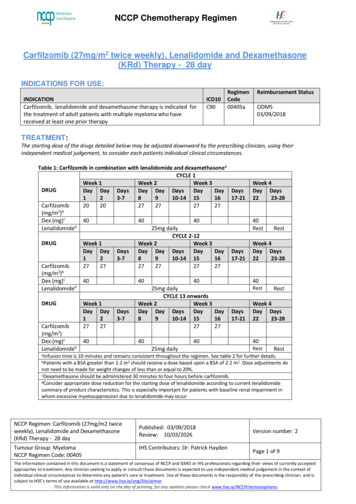
Transcription
NCCP Chemotherapy RegimenCarfilzomib (27mg/m2 twice weekly), Lenalidomide and Dexamethasone(KRd) Therapy - 28 dayINDICATIONS FOR USE:INDICATIONCarfilzomib, lenalidomide and dexamethasone therapy is indicated forthe treatment of adult patients with multiple myeloma who havereceived at least one prior therapyICD10C90RegimenCode00405aReimbursement StatusODMS03/09/2018TREATMENT:The starting dose of the drugs detailed below may be adjusted downward by the prescribing clinician, using theirindependent medical judgement, to consider each patients individual clinical circumstances.Table 1: Carfilzomib in combination with lenalidomide and dexamethasoneaCYCLE 1Week 1Week 2Week 3DRUGDay Day DaysDay Day DaysDayDay123-78910-14 1516Carfilzomib202027272727(mg/m2)bDex (mg)c404040dLenalidomide25mg dailyCYCLE 2-12DRUGWeek 1Week 2Week 3Day Day DaysDay Day DaysDayDay123-78910-14 1516Carfilzomib272727272727(mg/m2)bDex (mg)c404040Lenalidomided25mg dailyCYCLE 13 onwardsDRUGWeek 1Week 2Week 3Day Day DaysDay Day DaysDayDay123-78910-14 1516Carfilzomib27272727(mg/m2)Dex (mg)c404040Lenalidomided25mg dailyDays17-21Week 4Day Days2223-2840RestDays17-21RestWeek 4Day Days2223-2840RestDays17-21RestWeek 4Day Days2223-2840RestResttime is 10 minutes and remains consistent throughout the regimen. See table 2 for further details.bPatients with a BSA greater than 2.2 m2 should receive a dose based upon a BSA of 2.2 m2. Dose adjustments donot need to be made for weight changes of less than or equal to 20%.cDexamethasone should be administered 30 minutes to four hours before carfilzomib.dConsider appropriate dose reduction for the starting dose of lenalidomide according to current lenalidomidesummary of product characteristics. This is especially important for patients with baseline renal impairment inwhom excessive myelosuppression due to lenalidomide may occuraInfusionNCCP Regimen: Carfilzomib (27mg/m2 twiceweekly), Lenalidomide and Dexamethasone(KRd) Therapy - 28 dayTumour Group: MyelomaNCCP Regimen Code: 00405Published: 03/09/2018Review: 10/03/2026IHS Contributors: Dr. Patrick HaydenVersion number: 2Page 1 of 9The information contained in this document is a statement of consensus of NCCP and ISMO or IHS professionals regarding their views of currently acceptedapproaches to treatment. Any clinician seeking to apply or consult these documents is expected to use independent medical judgement in the context ofindividual clinical circumstances to determine any patient's care or treatment. Use of these documents is the responsibly of the prescribing clinician. and issubject to HSE’s terms of use available at http://www.hse.ie/eng/DisclaimerThis information is valid only on the day of printing, for any updates please check www.hse.ie/NCCPchemoregimens
NCCP Chemotherapy Regimen When combined with lenalidomide and dexamethasone, carfilzomib is administered on two consecutivedays, each week for three weeks (days 1, 2, 8, 9, 15, and 16), followed by a 12-day rest period (days 17to 28) as shown in table 1.Each 28-day period is considered one treatment cycle.Carfilzomib is administered at a starting dose of 20 mg/m2 (maximum dose 44 mg), in cycle 1 on days 1and 2.If tolerated, the dose should be increased on day 8 of cycle 1 to 27 mg/m 2 (maximum dose 60 mg).From cycle 13, carfilzomib is administered on days 1, 2, 15 and 16 only (day 8 and 9 doses of carfilzomibare omitted).Treatment may be continued until disease progression or until unacceptable toxicity occurs.Treatment with carfilzomib combined with lenalidomide and dexamethasone for longer than 18 cyclesshould be based on an individual benefit-risk assessment, as the data on the tolerability and toxicity ofcarfilzomib beyond 18 cycles are limited.Administration guidelines:Dexamethasone and lenalidomide are both administered orally.Carfilzomib is administered as detailed in table 2 below.Table 2: Administration details for carfilzomibCycle DayDrugDosea11, 2Carfilzomib20mg/m2b18, 9, 15,16 Carfilzomib27mg/m2RouteIV infusionIV infusionDiluent and Rate100ml Glucose 5%c over 10mins100ml Glucose 5%c over 10minsaMaximumdose of carfilzomib is 44mgdose of carfilzomib is 60mgcCarfilzomib may be administered in 50-100ml Glucose 5% over 10mins.Carfilzomib is a proteasome inhibitor and is neurotoxic. Refer to NCCP Guidance on the Safe Use of Neurotoxicdrugs (including Vinca Alkaloids) in the treatment of cancer.bMaximumELIGIBILITY: Indication as aboveECOG 0-2EXCLUSIONS: Hypersensitivity to carfilzomib, lenalidomide or any of the excipients.Pregnancy.BreastfeedingWomen of childbearing potential unless all the conditions of the Revlimid Pregnancy PreventionProgramme are met.PRESCRIPTIVE AUTHORITY:The treatment plan must be initiated by a Consultant Haematologist working in the area of haematologicalmalignancies.NCCP Regimen: Carfilzomib (27mg/m2 twiceweekly), Lenalidomide and Dexamethasone(KRd) Therapy - 28 dayTumour Group: MyelomaNCCP Regimen Code: 00405Published: 03/09/2018Review: 10/03/2026IHS Contributors: Dr. Patrick HaydenVersion number: 2Page 2 of 9The information contained in this document is a statement of consensus of NCCP and ISMO or IHS professionals regarding their views of currently acceptedapproaches to treatment. Any clinician seeking to apply or consult these documents is expected to use independent medical judgement in the context ofindividual clinical circumstances to determine any patient's care or treatment. Use of these documents is the responsibly of the prescribing clinician. and issubject to HSE’s terms of use available at http://www.hse.ie/eng/DisclaimerThis information is valid only on the day of printing, for any updates please check www.hse.ie/NCCPchemoregimens
NCCP Chemotherapy RegimenTESTS:Baseline tests: FBC, renal, liver and bone profile Blood pressure, blood glucose (patients on oral hypoglycaemics) Assessment of peripheral neuropathy status VTE risk assessment Pregnancy test in women of child-bearing age or evidence of a hysterectomy. Assessment andregistration as per Pregnancy Prevention Program for both male and female patients. Virology screen -Hepatitis B (HBsAg, HBcoreAb), C and HIV*(Reference Adverse Events/Regimen Specific Complications for information on Hepatitis B reactivation)Regular tests: FBC, renal and liver profile monthly. Blood pressure, *blood glucose if being treated with oral hypoglycaemics. (* See DrugInteractions) Pregnancy test every 28 days if female of childbearing potential. Consider monitoring thyroid function tests.Disease monitoring:Disease monitoring should be in line with the patient’s treatment plan and any other test/s as directedby the supervising ConsultantDOSE MODIFICATIONS: Any dose modification should be discussed with a ConsultantDose adjustments of carfilzomib do not need to be made for weight changes of less than or equalto 20% subject to local policy.Lenalidomide treatment must not be started if the ANC is 1x 109/L and/or platelets 75 x 109/Lor dependent on bone marrow infiltration by plasma cells, platelet counts 30 x 109/LDose level reductions for carfilzomib and lenalidomide are described in Table 3 belowTreatment guidelines for specific hematologic toxicities (thrombocytopenia and neutropenia ) areoutlined in Tables 4 and 5.Table 3: Dose Level Reductions for Carfilzomib and LenalidomideCarfilzomibLenalidomide2Starting Dose27mg/m25mgDose level -120mg/m215mgaDose level -215mg/m215mg every 48 hoursDose level- 310mgDose level-45mga Ifsymptoms do not resolve, discontinue carfilzomib treatmentNCCP Regimen: Carfilzomib (27mg/m2 twiceweekly), Lenalidomide and Dexamethasone(KRd) Therapy - 28 dayTumour Group: MyelomaNCCP Regimen Code: 00405Published: 03/09/2018Review: 10/03/2026IHS Contributors: Dr. Patrick HaydenVersion number: 2Page 3 of 9The information contained in this document is a statement of consensus of NCCP and ISMO or IHS professionals regarding their views of currently acceptedapproaches to treatment. Any clinician seeking to apply or consult these documents is expected to use independent medical judgement in the context ofindividual clinical circumstances to determine any patient's care or treatment. Use of these documents is the responsibly of the prescribing clinician. and issubject to HSE’s terms of use available at http://www.hse.ie/eng/DisclaimerThis information is valid only on the day of printing, for any updates please check www.hse.ie/NCCPchemoregimens
NCCP Chemotherapy RegimenHaematological:Table 4: Dose Modifications for ThrombocytopeniaPlateletsLenalidomideFall toHold lenalidomide therapy, 30 x 109/Lfollow FBC weekly. Holdprophylactic anticoagulationuntil platelets return to 30x109/L then resume at1dose decrementFor each subsequentdrop to 30 x 109/LHold lenalidomide therapy,follow FBC weekly. Holdprophylactic anticoagulationuntil platelets return to 30x109/L then resume atadditional dose decrement.Do not dose below 5mgonce dailyTable 5: Dose Modifications for NeutropeniaANCLenalidomideFalls toHold lenalidomide therapy, 1.0 x 109/Ladminister G-CSF, followFBC weekly; then resume atfull dose when ANC 1.0x109/LFor each subsequentHold lenalidomide therapy,drop to 1.0 x 109/Ladminister G-CSF, followFBC weekly; then resume at1 dose decrement whenANC 1.0x109/LPlateletsIf 10-30 x 109/L withoutevidence of bleedingCarfilzomibMaintain full doseIf 10 x 109/L orevidence of bleedingHold dose until platelets return to 10 x 109/L and/or bleeding iscontrolled then resume at samedose levelIf 10-30 x 109/L withoutevidence of bleedingIf 10 x 109/L orevidence of bleedingMaintain full doseHold dose until platelets return to 10 x 109/L and/or bleeding iscontrolled, then consider 1 doselevel reduction when restartingcarfilzomib.ANC0.5-1.0 x 109/LCarfilzomibMaintain full dose 0.5 x 109/LHold doseResume at full dose when ANC 0.5 x 109/L0.5-1.0 x 109/LMaintain full doseFor subsequent dropsto 0.5 x 109/LHold doseResume when ANC 0.5 x 109/Land consider 1 dose levelreductionHold doseIf ANC returns to baseline gradeand fever resolves, resume atsame dose levelFebrile neutropeniaANC 0.5 x 109/L andan oral temperature 38.50C or twoconsecutive readings of 38.00C for 2 hoursIn the case of neutropenia, the use of growth factors in patient management should be consideredNCCP Regimen: Carfilzomib (27mg/m2 twiceweekly), Lenalidomide and Dexamethasone(KRd) Therapy - 28 dayTumour Group: MyelomaNCCP Regimen Code: 00405Published: 03/09/2018Review: 10/03/2026IHS Contributors: Dr. Patrick HaydenVersion number: 2Page 4 of 9The information contained in this document is a statement of consensus of NCCP and ISMO or IHS professionals regarding their views of currently acceptedapproaches to treatment. Any clinician seeking to apply or consult these documents is expected to use independent medical judgement in the context ofindividual clinical circumstances to determine any patient's care or treatment. Use of these documents is the responsibly of the prescribing clinician. and issubject to HSE’s terms of use available at http://www.hse.ie/eng/DisclaimerThis information is valid only on the day of printing, for any updates please check www.hse.ie/NCCPchemoregimens
NCCP Chemotherapy RegimenRenal and Hepatic Impairment:Table 6: Dose modification of carfilzomib and lenalidomide based on renal functionCarfilzomib No starting dose adjustment for carfilzomib is required in patients withbaseline mild, moderate, or severe renal impairment or patients on chronicdialysis. Renal function should be monitored, particularly in patients with lowerbaseline creatinine clearance (CrCL 30 mL/min). If Serum creatinine 2 baseline or if Creatinine clearance 15 mL/min (orcreatinine clearance decreases to 50% of baseline) or need for dialysis,stop dose and continue monitoring renal function (serum creatinine orcreatinine clearance). Carfilzomib should be resumed when renal function has recovered towithin 25% of baseline; consider resuming at 1 dose level reduction. Since dialysis clearance of carfilzomib concentrations has not been studied,the medicinal product should be administered after the dialysis procedure. There are limited efficacy and safety data on patients with baselinecreatinine clearance 30 mL/min.LenalidomideCreatinine Clearanceml/min30 to 50 30 not requiring dialysis 30 requiring dialysisDose modificationReduce dose to 10mg once daily*15mg every other dayReduce dose to 5mg once daily. On dialysis daysdose should be administered after dialysis.*The dose may be escalated to 15mg once daily after 2 cycles if patient is notresponding to treatment and is tolerating the treatmentHepatic impairment:Table 7: Dose modification of carfilzomib and lenalidomide based on hepatic functionCarfilzomib No starting dose adjustment is recommended in patients with mild or moderatehepatic impairment based on available pharmacokinetic data. However, higher subject incidence of hepatic function abnormalities, grade 3adverse events and serious adverse events have been reported in patients withmild or moderate baseline hepatic impairment compared with patients withnormal hepatic function. Liver enzymes and bilirubin should be assessed at treatment initiation andmonitored monthly during treatment with carfilzomib, regardless of baselinevalues, and appropriate dose modifications based on toxicity should be madeLenalidomide Lenalidomide has not formally been studied in patients with impaired hepaticfunction and there are no specific dose recommendationsNCCP Regimen: Carfilzomib (27mg/m2 twiceweekly), Lenalidomide and Dexamethasone(KRd) Therapy - 28 dayTumour Group: MyelomaNCCP Regimen Code: 00405Published: 03/09/2018Review: 10/03/2026IHS Contributors: Dr. Patrick HaydenVersion number: 2Page 5 of 9The information contained in this document is a statement of consensus of NCCP and ISMO or IHS professionals regarding their views of currently acceptedapproaches to treatment. Any clinician seeking to apply or consult these documents is expected to use independent medical judgement in the context ofindividual clinical circumstances to determine any patient's care or treatment. Use of these documents is the responsibly of the prescribing clinician. and issubject to HSE’s terms of use available at http://www.hse.ie/eng/DisclaimerThis information is valid only on the day of printing, for any updates please check www.hse.ie/NCCPchemoregimens
NCCP Chemotherapy RegimenNon-Haematological Toxicities:Table 8: Dose modifications for non-haematological toxicity for carfilzomibAdverse EventCarfilzomibNon-haematologic toxicity (renal )Hold dose and continue monitoring renal function (serumSerum creatinine 2 baseline;creatinine or creatinine clearance)ORCreatinine clearance 15 mL/min(or creatinine clearance decreases to 50% of baseline) or need fordialysisAll other grade 3 or 4 nonhaematologic toxicitiesaCarfilzomib should be resumed when renal function hasrecovered to within 25% of baseline; consider resuming at 1 doselevel reductionaFor patients on dialysis receiving carfilzomib, the dose is to beadministered after the dialysis procedureStop carfilzomib until resolved or returned to baseline.Consider restarting the next scheduled treatment at 1 dose levelreductionaSee table 3 for dose level reductionsSUPPORTIVE CARE:EMETOGENIC POTENTIAL:Carfilzomib: Low (Refer to local policy).Lenalidomide: Minimal to low (Refer to local policy).PRE-MEDICATIONS: Adequate hydration is required before dose administration in cycle 1, especially in patients at high riskof tumour lysis syndrome or renal toxicity All patients should be monitored for evidence of volume overload and fluid requirements should betailored to individual patient needs The total volume of fluids may be adjusted as clinically indicated in patients with baseline cardiac failureor who are at risk for cardiac failure Recommended hydration includes botho oral fluids (30 mL/kg/day for 48 hours before day 1 of cycle 1) ando intravenous fluids (250 mL to 500 mL of appropriate intravenous fluid before each dose in cycle 1).o Give an additional 250 mL to 500 mL of intravenous fluids as needed following carfilzomibadministration in cycle 1 Oral and/or intravenous hydration should be continued, as needed, in subsequent cycles. Serum potassium levels should be monitored monthly or more frequently during treatment withcarfilzomib as clinically indicated. The frequency of assessment will depend on the potassium levelsmeasured before the start of treatment, concomitant therapy used (e.g. medicinal products known toincrease the risk of hypokalaemia) and associated comorbidities Ensure patient remains well hydrated during treatmentNCCP Regimen: Carfilzomib (27mg/m2 twiceweekly), Lenalidomide and Dexamethasone(KRd) Therapy - 28 dayTumour Group: MyelomaNCCP Regimen Code: 00405Published: 03/09/2018Review: 10/03/2026IHS Contributors: Dr. Patrick HaydenVersion number: 2Page 6 of 9The information contained in this document is a statement of consensus of NCCP and ISMO or IHS professionals regarding their views of currently acceptedapproaches to treatment. Any clinician seeking to apply or consult these documents is expected to use independent medical judgement in the context ofindividual clinical circumstances to determine any patient's care or treatment. Use of these documents is the responsibly of the prescribing clinician. and issubject to HSE’s terms of use available at http://www.hse.ie/eng/DisclaimerThis information is valid only on the day of printing, for any updates please check www.hse.ie/NCCPchemoregimens
NCCP Chemotherapy RegimenOTHER SUPPORTIVE CARE: Antiviral prophylaxis should be considered in patients being treated with carfilzomib to decrease therisk of herpes zoster reactivation (Refer to local policy) Tumour Lysis Syndrome (TLS) has been reported in patients receiving carfilzomib. As well as adequateprophylaxis, consider prophylactic treatment e.g. allopurinol (Refer to local policy) Thromboprophylaxis (Refer to local policy) In case of neutropenia the consultant may consider the use of filgrastim (G-CSF) Prophylactic laxatives to prevent lenalidomide-induced constipation (Refer to local policy). Bisphosphonates should be considered in all patients with myeloma-related bone disease. Consider the use of a H2 antagonist or proton pump inhibitor if appropriate in patients receivingdexamethasone therapy (Refer to local policy).ADVERSE EFFECTS / REGIMEN SPECIFIC COMPLICATIONSThe adverse effects listed are not exhaustive. Please refer to the relevant Summary of Product Characteristics for full details.Carfilzomib and lenalidomide are subject to additional monitoring. Healthcare professionals are asked to report anysuspected adverse reactions. Hepatitis B Reactivation: Patients should be tested for both HBsAg and HBcoreAb as per local policy. Ifeither test is positive, such patients should be treated with anti-viral therapy. (Refer to local infectiousdisease policy). These patients should be considered for assessment by hepatology.Carfilzomib Cardiovascular: New or worsening cardiac failure (e.g. congestive cardiac failure, pulmonary oedema,decreased ejection fraction), myocardial ischaemia and infarction have occurred following administrationof carfilzomib. While adequate hydration is required prior to dosing in cycle 1, all patients should bemonitored for evidence of volume overload, especially patients at risk for cardiac failure. The total volumeof fluids may be adjusted as clinically indicated in patients with baseline cardiac failure or who are at riskfor cardiac failure. Stop carfilzomib for grade 3 or 4 cardiac events until recovery and consider whetherto restart carfilzomib at 1 dose level reduction based on a benefit/risk assessment. The risk of cardiac failure is increased in elderly patients ( 75 years). Patients with signs or symptoms ofNYHA Class III or IV cardiac failure, recent history of myocardial infarction (in the last 4 months), and inpatients with uncontrolled angina or arrhythmias, should have a comprehensive medical assessment,prior to starting treatment with carfilzomib. This assessment should optimise the patient’s status, withparticular attention to blood pressure and fluid management. Subsequently patients should be treatedwith caution and remain under close follow-up. Electrocardiographic changes: There have been cases of QT interval prolongation reported in clinicalstudies with carfilzomib. An effect of carfilzomib on QT interval cannot be excluded. Pulmonary toxicity: Acute respiratory distress syndrome (ARDS), acute respiratory failure, and acutediffuse infiltrative pulmonary disease such as pneumonitis and interstitial lung disease have occurred inpatients receiving carfilzomib. Some of these events have been fatal. Evaluate and stop carfilzomib untilresolved and consider whether to restart carfilzomib based on a benefit/risk assessment. Hypertension: Hypertension, including hypertensive crisis and hypertensive emergency, has beenobserved with carfilzomib. Some of these events have been fatal. It is recommended to controlhypertension prior to starting treatment. All patients should be routinely evaluated for hypertensionwhile on carfilzomib and treated as needed. If the hypertension cannot be controlled, the carfilzomibdose should be reduced. In case of hypertensive crises, stop carfilzomib until resolved or returned toNCCP Regimen: Carfilzomib (27mg/m2 twiceweekly), Lenalidomide and Dexamethasone(KRd) Therapy - 28 dayTumour Group: MyelomaNCCP Regimen Code: 00405Published: 03/09/2018Review: 10/03/2026IHS Contributors: Dr. Patrick HaydenVersion number: 2Page 7 of 9The information contained in this document is a statement of consensus of NCCP and ISMO or IHS professionals regarding their views of currently acceptedapproaches to treatment. Any clinician seeking to apply or consult these documents is expected to use independent medical judgement in the context ofindividual clinical circumstances to determine any patient's care or treatment. Use of these documents is the responsibly of the prescribing clinician. and issubject to HSE’s terms of use available at http://www.hse.ie/eng/DisclaimerThis information is valid only on the day of printing, for any updates please check www.hse.ie/NCCPchemoregimens
NCCP Chemotherapy Regimen baseline and consider whether to restart carfilzomib based on a benefit/risk assessment.Infusion reactions: Infusion reactions, including life-threatening reactions, have been reported in patientswho received carfilzomib. These reactions can occur immediately following or up to 24 hours afteradministration of carfilzomib. Dexamethasone should be administered prior to carfilzomib to reduce theincidence and severity of reactions.Lenalidomide Teratogenetic effects: Lenalidomide is structurally related to thalidomide a powerful human teratogen.It must never be used by women who are pregnant or by women who could become pregnant unless allthe conditions of the Revlimid Pregnancy Prevention Programme are met. Skin reactions: Lenalidomide must be discontinued permanently for exfoliative or bullous rash or ifStevens-Johnson syndrome (SJS) or toxic epidermal necrolysis (TEN) is suspected. Cardiovascular: Patients with known risk factors for MI, including prior thrombosis should be closelymonitored and action should be taken to try to minimise all modifiable risk factors (e.g. smoking,hypertension and hyperlipidaemia). There is an increased risk of venous and arterial thromboembolismin patients treated with lenalidomide and dexamethasone. Previous history of thromboembolic events orconcomitant administration of erythropoietic agents or other agents such as hormone replacementtherapy, may also increase thromboembolic risk in these patients. Particularly, a haemoglobinconcentration above 12g/dl should lead to discontinuation of erythropoietic agents. Thromboprophylaxisshould be considered especially in patients with additional thrombotic risk factors. Peripheral Neuropathy: Lenalidomide is structurally related to thalidomide which is known to inducesevere peripheral neuropathy. The neurotoxic potential of lenalidomide associated with long-term usecannot be ruled out. Thyroid function: Cases of hypothyroidism have been reported and baseline and ongoing monitoring ofthyroid function is recommended. Tumour lysis syndrome: Patients at risk of tumour lysis syndrome are those with high tumour burdenprior to treatment. These patients should be monitored closely and appropriate precautions taken. Pulmonary hypertension: Cases of pulmonary hypertension, some fatal, have been reported in patientstreated with lenalidomide. Patients should be evaluated for signs and symptoms of underlyingcardiopulmonary disease prior to initiating and during lenalidomide therapy.DRUG INTERACTIONS: Carfilzomib is primarily metabolised via peptidase and epoxide hydrolase activities, and as a result, thepharmacokinetic profile of carfilzomib is unlikely to be affected by concomitant administration ofcytochrome P450 inhibitors and inducers.Erythropoietic agents, or other agents that may increase the risk of thrombosis, such as hormonereplacement therapy, should be used with caution in multiple myeloma patients receiving lenalidomidewith dexamethasoneThere is an increased risk of rhabdomyolysis when statins are administered with lenalidomide, which maybe simply additive. Enhanced clinical and laboratory monitoring is warranted notably during the firstweeks of treatment.Current drug interaction databases should be consulted for more information.NCCP Regimen: Carfilzomib (27mg/m2 twiceweekly), Lenalidomide and Dexamethasone(KRd) Therapy - 28 dayTumour Group: MyelomaNCCP Regimen Code: 00405Published: 03/09/2018Review: 10/03/2026IHS Contributors: Dr. Patrick HaydenVersion number: 2Page 8 of 9The information contained in this document is a statement of consensus of NCCP and ISMO or IHS professionals regarding their views of currently acceptedapproaches to treatment. Any clinician seeking to apply or consult these documents is expected to use independent medical judgement in the context ofindividual clinical circumstances to determine any patient's care or treatment. Use of these documents is the responsibly of the prescribing clinician. and issubject to HSE’s terms of use available at http://www.hse.ie/eng/DisclaimerThis information is valid only on the day of printing, for any updates please check www.hse.ie/NCCPchemoregimens
NCCP Chemotherapy RegimenCOMPANY SUPPORT RESOURCES/Useful Links:Please note that this is for information only and does not constitute endorsement by the :1. Keith Stewart A et al. Carfilzomib, Lenalidomide, and Dexamethasone for Relapsed Multiple Myeloma. NEngl J Med 2015;372:142-522. NCCP Classification Document for Systemic Anti-Cancer Therapy (SACT) Induced Nausea and Vomiting.V2 2019. Available at: -and-vomiting.pdf3. Kyprolis Summary of Product Characteristics. Accessed February 2021. Available nformation/kyprolis-epar-productinformation en.pdf4. Revlimid Summary of Product Characteristics Accessed February 2021.Available nformation/revlimid-epar-productinformation proved ByDr Patrick HaydenUpdate of regimen titleUpdate of management of Hepatitis B Reactivationand emetogenic potentialComments and feedback welcome at oncologydrugs@cancercontrol.ie.NCCP Regimen: Carfilzomib (27mg/m2 twiceweekly), Lenalidomide and Dexamethasone(KRd) Therapy - 28 dayTumour Group: MyelomaNCCP Regimen Code: 00405Published: 03/09/2018Review: 10/03/2026IHS Contributors: Dr. Patrick HaydenVersion number: 2Page 9 of 9The information contained in this document is a statement of consensus of NCCP and ISMO or IHS professionals regarding their views of currently acceptedapproaches to treatment. Any clinician seeking to apply or consult these documents is expected to use independent medical judgement in the context ofindividual clinical circumstances to determine any patient's care or treatment. Use of these documents is the responsibly of the prescribing clinician. and issubject to HSE’s terms of use available at http://www.hse.ie/eng/DisclaimerThis information is valid only on the day of printing, for any updates please check www.hse.ie/NCCPchemoregimens
NCCP Chemotherapy Regimen NCCP Regimen: Carfilzomib (27mg/m2 twice weekly), Lenalidomide and Dexamethasone (KRd) Therapy - 28 day Published: 03/09/2018
